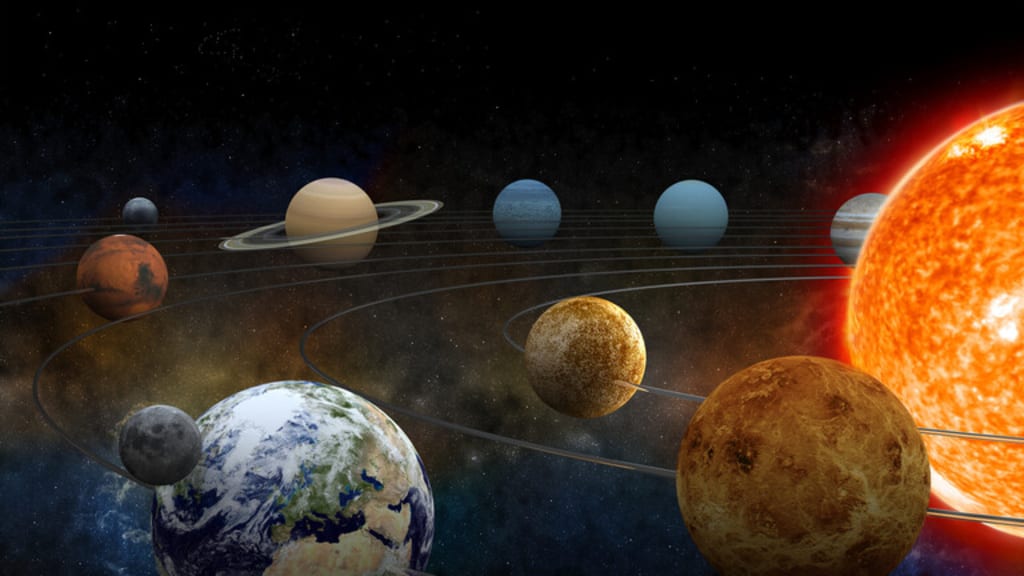Discovering the "missing link" in the search for the origin of water in our solar system
Scientists studying the formation of a distant star inside a dusty cloud have found what they say is the "missing link" in the search for the source of water in our solar system.

Scientists say the star located 1,300 light-years away from Earth, in the constellation Orion, can finally explain the origins of water on Earth.
The protostar is called V883 Orionis, and it is a young star surrounded by a huge disk of material that will one day fuse to form larger bodies, such as planets, orbiting it.
In this disc, scientists discovered gaseous water with a chemical composition close to that found in comets orbiting the Earth. This is vital evidence that the water that comets brought to ancient Earth came from gas clouds older than the sun.
"We can now trace the origins of water in our solar system back before the formation of the sun," said John J. Tobin, an astronomer at the US National Radio Astronomy Observatory and lead author of the study published today in the journal Nature.
The team of astronomers used ALMA, or the Atacama Large Millimeter/Submillimeter Array (ALMA), the Large Radio Telescope in Chile, to search for the chemical signatures of the water in the cloud.
Previous research has shown that water in solar system comets is similar to water on Earth, indicating that previous comets may have delivered it to our planet. But there was a missing link in the process: the one that connected young stars to comets. And now, in new findings, scientists have finally filled that void.
"The measurement we made kind of fills in the big gap in our knowledge of what happens between the protostar stage, when the star is first being created, versus comets, where it's kind of a remnant of the planet-forming process," Tobin explained. "We've never been able to measure the formation of water in a protoplanetary disk." first before".
Tobin continued: “V883 Orionis is the missing link in this case. The composition of water in the disk is very similar to the composition of comets in our solar system. This confirms the idea that water in planetary systems was formed billions of years ago, before the sun, in interstellar space, and was inherited by both Comets and Earth, relatively unchanged."
In total, the team found that V883 Orionis contains at least 1,200 times as much water as Earth's oceans. The team plans to conduct more observations to better see the water in its gaseous state in such discs. Source: The Independent
"The exile of the Earth and the end of life" This is what would have happened if our solar system had acquired a super-Earth
Simulations have revealed that our planet could be pushed into the depths of interstellar space outside the solar system, ending life on Earth.
Computer simulations conducted by Stephen Kane , an astrophysicist at the University of California, Riverside, examined a hypothetical extra Earth-like planet between Mars and Jupiter and analyzed its effects on the orbits of all the planets in our solar system .
Simulations found that adding a planet between Mars and Jupiter to our fine-tuned solar system could destabilize its orbits and eventually end life on Earth.
While the formation of a whole new neighborhood world is fortunately unlikely, the findings have implications for efforts to search for life in other solar systems.
According to Professor Kane, the purpose of his experiment was to explore two notable gaps in the formation of our solar system compared to others.
The first is the gap between the sizes of the terrestrial planets, the largest of which is Earth, and the gas giants, the smallest of which is Neptune, which is actually four times larger than Earth and has a mass 17 times the mass of our planet.
And the second gap is in the location. In relation to the sun, there are no planets between the orbits of Mars and Jupiter.
Our solar system is somewhat unique in that it contains life-supporting Earths but no super-Earths.
Super-Earths are a class of planets that often orbit other stars. It is defined solely by its mass, which ranges between 2 and 10 Earth masses.
And while searching for other galaxies and exoplanets over the years, scientists have noticed that super-Earths are relatively normal, except in our solar system.
Because there is no representative super-Earth here, it is difficult for planetary scientists to understand these types of planets in other systems.
The astrophysicist explained that understanding the cause of each of the two gaps could provide key insights into the structure of our solar system, as well as the evolution of Earth.
Accordingly, Professor Kane ran a series of dynamic computer simulations adding a planet between Mars and Jupiter, looking at a range of different masses for such an object, and observing what kind of effects it had on the orbits of other planets.
The results have been largely disastrous for the solar system - and for life on Earth. "This imaginary planet gives Jupiter enough of a boost to destabilize everything else," Professor Kane explained.
Jupiter is much larger than all the other planets combined, with a mass of 318 times that of Earth, which means that its gravitational influence is profound.
Accordingly, even the slightest perturbation of Jupiter by adding a terrestrial planet could profoundly affect the orbits of all the other planets in the solar system.
In fact, depending on its extreme mass and exact location, its presence could eventually drive Mercury, Venus, Earth, Uranus, and Neptune out of the solar system.
And even if Earth weren't catapulted into deep space, adding a super-Earth to the solar system would certainly change its orbit, making our home at least more hostile to life, if not outright inhospitable.
Professor Kane added: "Although many astronomers would like this extra planet to exist, it is a good thing we don't have it."
The only way the astrophysicist has found for the planet to remain stable for a relatively long period is to make its mass smaller, at which point a small window opens for it between Mars and Jupiter.
However, even slight changes in its orbital trajectory will make things go badly, according to Professor Kane.
The full results of the study have been published in The Planetary Science Journal.
China launches two Earth remote sensing satellites
On March 10, China successfully launched two Tianhui-6 remote-sensing Earth satellites.
The Chinese newspaper "Junguo Hantiang Bao" reported on its page on the social network WeChat that the two satellites were launched by a CZ-4C rocket at 06.41 local time (01.41 Moscow time) from the Taiwang airport in the north of the country.
It is noteworthy that the two satellites, Tianhui-6, will be used to develop geographical maps, study natural resource fields, and conduct scientific experiments.
Beijing has been actively developing its space program by launching meteorological, astronautical, communications and remote sensing satellites, as well as developing moon reclamation technologies. At the same time, Chinese specialists are implementing projects to study asteroids and Mars. Last year, China completed the construction of its space station in Earth's orbit. Source: TASS
"Ross Cosmos" displays for the first time the process of separating the stages of the Proton-M rocket in space
The Russian Ross Cosmos Foundation published on its Telegram channel a video clip showing the process of separating the stages of the Proton-M rocket in space, which was launched in early February.
The clip shows how the first stage separated from the main body of the rocket and plunged towards Earth, so that the rocket could continue its mission into space.
"If you missed the moment of the missile's launch, here is a snapshot showing the process of separating its stages, which was taken from cameras that were installed on it," Ross Cosmos said in a comment on the video.
In early February, the Ross Cosmos Foundation announced the successful launch of a Proton-M space rocket, which carried the fourth Russian Electro-L satellite, which is used in meteorology and tracking natural phenomena, into space.
Russia launched the first satellites of the "Electro-L" group from the "Baikonur" base in 2011, and in 2015 it launched the second satellite, and launched the third of these satellites last year. Source: Vesti
About the Creator
News Correct
Information WorldWide MORE INFORMATION
Enjoyed the story? Support the Creator.
Subscribe for free to receive all their stories in your feed. You could also pledge your support or give them a one-off tip, letting them know you appreciate their work.






Comments
There are no comments for this story
Be the first to respond and start the conversation.